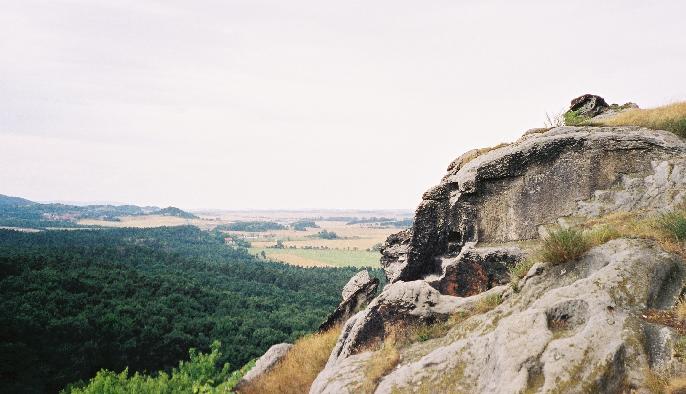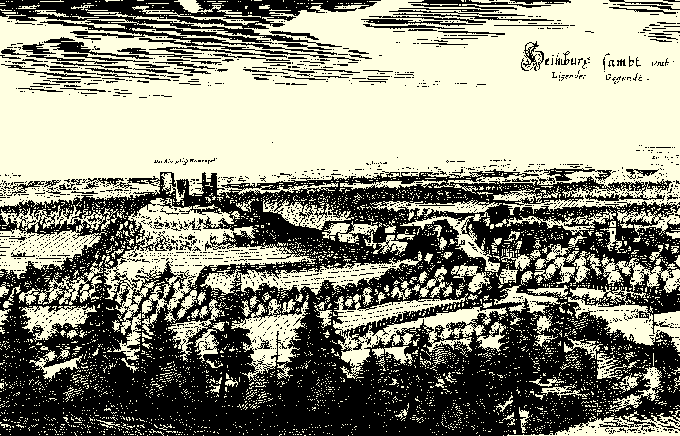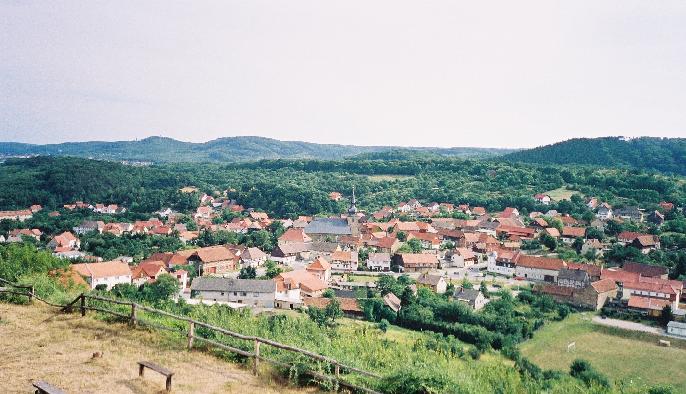
Y E T A N O T H E R H E I M B U R G W E B S I T E
News
Coat of Arms
History
Castle
Family Union
About Me
Links
C A S T L E
The Heimburg am Harz
...was the first castle awarded to the family. Its name translates into Home Castle at the Harz, the Harz being a low mountain range in mid-Germany. Situated on an isolated hill right in front of the Harz, it overlooked a great plain to the - don't nail me to this - North-East.

A look from the castle Regenstein onto the hill of the Heimburg (the lone round one in front of the mountains).
The v. Heimburg family got this castle and the surrounding lands in the 12th century as a fiefdom, a reward for being successful in battle; the castle itself is older. We are not and never were in possession of the castle, but had the right to deduct taxes from the people living on the country and judge when a judge was needed, and had the duty to defend the land or go into war with the king when necessary. This was standard procedure, the land and all its castles were always owned by the current ruler. Knights and the likes were his representatives and responsible for their assigned land. Now, the hill on which the Heimburg stood belongs to the Federal Republic of Germany.
Below is an etching of the Heimburg in 1654 by Conrad Bruno. The picture was scannend and first put on the web by Heino, now also on display here.

As you can see, the Heimburg was already a ruin back then. Now, there's
almost nothing left of it.
The village on the right still exists today, it's Heimburg (inventive, isn't it?) in the county of Werningerode.

The village Heimburg, as seen from the castle hill.
[top]
Details
With an area of 150x60m², the castle and its surrounding fortifications once covered almost the entire hill. Form 1891 to 1894, the Baurat[engl.?] of Blankenburg, Heinrich Brinkmann, unearthed major parts: Two gates, an outer and an inner ring wall, a well and the foundations of several towers were discovered. Most of what was left of the buildings was destroyed in the early 1980's when an observation bunker was built on the site of the old castle. To the north-west of the core castle a big moat is still preserved, it stretches down in south-eastern direction into the valley (old or second entrance?). The hill itself shows artificial terraces in the north-east and south-west, they possibly once beared additional fortifications. The baroque domain building in the valley probably once was an additional, smaller castle that guarded the entry to the main one. Right to its east, a lot of major Middle Age routes crossed.
The etching above shows the demolished state of the castle after the destructions during the 30-Year War. The ruins were used as a quarry until the 19th century. Also in the 19th century, there were attempts to reshape the hill as a park, some signs of it are still visible today.
[top]
History of the Castle
The Heimburg probably already served as a stronghold to protect the access to the important resources of the Harz in the 10th century. Important routes from the North (Magdeburg / Halberstadt from the palatinates Werla, Derenburg, Quedlinburg and from Lüneburg / Braunschweig) in the Middle Ages went via Heimburg, the Harz and from there on farther southwards to South Germany and Italy. A lot of remaining narrow passes are still an impressive proof for this. The castle was first mentioned in the records of Lambert v. Hersfeld in 1073 as a castle of Heinrich IV.
The Saxon chronologer calls it a Reichsburg [castle of the empire] which was destroyed on February 11, 1115 by the victorious Saxons after the battle of Welfenholz. In 1123, the Bishop of Halberstadt, Reinhard, attempted to resurrect the castle, but the Saxon duke Lothar v. Supplinenburg faught this entreprise from his castle Blankenburg.
In 1143, a document from the 14-year-old emperor Heinrich der Löwe [Henry the Lion] for the first time mentions a liege lord, Anno v. Heimburg. The castle seems to have been resurrected thereafter. In 1180/1181 it was temporarily surrendered to the enemies of Henry the Lion, lead by Friedrich I. Barbarossa. From 1263 to 1267 the castle was in the hands of Ulrich I. v. Regenstein who founded his line there. Until the death of the last of the Regensteins on July 9, 1599 it stayed in the posession of that family. It was first reported a ruin in 1654.
Since 1990 the castle has been reshaped and reopened to the public.
[top]
There is another castle, also called Heimburg, located in the Rhine valley. Recent findings indicate that there is no connection between that castle and the family.
[top]
© 2001-2004 by Anno v. Heimburg except where stated otherwise (see credits).
Use of this website is subject to these conditions.